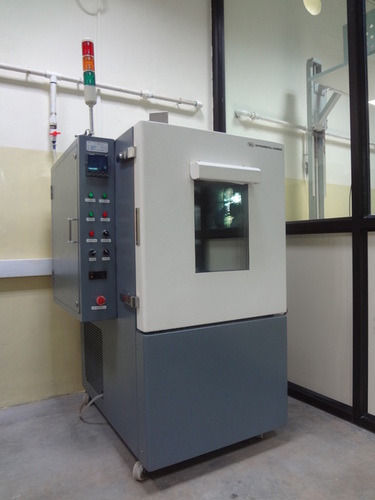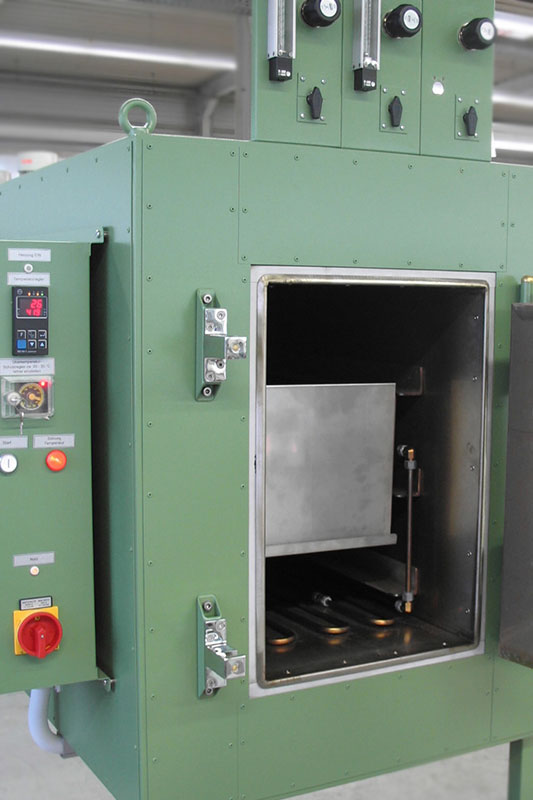Thermal Cycling Chamber
Product Details:
- Power Supply Electric
- Control Type PID Microprocessor Controller
- Glass Type Tempered View Window
- Heating Capacity 4 kW
- Shape Rectangular
- Display Type Digital LED
- Accuracy 0.5C
- Click to View more
X
Thermal Cycling Chamber Product Specifications
- PID Microprocessor Controller
- Electric
- 300 Ltr
- Thermal Cycling Chamber
- 4 kW
- 3 KW
- Laboratory
- Tempered View Window
- Thermal Cycling Chamber
- 0.5C
- Rectangular
- Digital LED
- Testing Thermal Resistance and Durability of Components
- Other
- Up to 10C/min
- 220-240V AC, 50Hz
- -40C to +150C
- Stainless Steel
- 1260 x 840 x 1770 mm
- Programmable Cycles, Overheat Protection, Safety Alarm, Data Recording
- Stainless Steel Chamber, Powder Coated Outer Body
- White Grey
Thermal Cycling Chamber Trade Information
- Central America, North America, South America, Eastern Europe, Western Europe, Middle East, Asia, Australia, Africa
- All India
Product Description
Committed towards quality, we are putting forth the best quality Thermal Cycling Chamber. The provided cycling chamber is precisely manufactured by utilizing excellent grade components under the surveillance of our deft professionals. Widely used for testing the sudden change in the temperature, the offered cycling chamber finds its usage in several industrial applications. Besides, our clients can purchase this Thermal Cycling Chamber at marginal prices from us.
Features:
Features:
- Low noise generation
- High speed functioning
- Fully automatic
- Compact built
- Temperature controlling accuracy: +-2 Deg C
- Humidity controlling accuracy: +-2 - 3% @ 40% to 98% Rh
- Sensor : Class A-grade, PT-100
- Standard sizes: 600 mm x 600 mm x 600 mm/750 mm x 750 mm x 750 mm/1000 mm x 1000 mm x 1000 mm
- Temperature range: 10 V c to 60 V c
- Humidity range: 40% to 98% Rh @ (30 Deg c to 80 Deg)
FAQs of Thermal Cycling Chamber:
Q1. What is a Thermal Cycling Chamber?
A1. A Thermal Cycling Chamber is a laboratory equipment used to simulate temperature and humidity fluctuations. It can be used to test the effects of temperature and humidity on a variety of materials and products.
Q2. What is the color of a Thermal Cycling Chamber?
A2. The standard color of a Thermal Cycling Chamber is white grey.
Q3. What type of sensor does a Thermal Cycling Chamber use?
A3. A Thermal Cycling Chamber typically uses a Class A-grade PT-100 sensor.
Q4. What is the temperature range of a Thermal Cycling Chamber?
A4. The temperature range of a Thermal Cycling Chamber is 10 V c to 60 V c.
Versatile Environmental Testing
The chamber enables comprehensive thermal and humidity testing, supporting programmable cycles from -40C to +150C and humidity from 20% to 98% RH. This makes it ideal for simulating a wide array of environmental conditions in laboratories.
Precision Control and Data Logging
Featuring a PID microprocessor controller, digital LED display, and data recording capabilities, the chamber ensures accurate monitoring and control. The interface supports both local and remote operation via RS232/USB for efficient test management and analysis.
Robust Construction for Safety and Durability
Built with a powder-coated steel body, stainless steel chamber, and tempered glass window, the chamber stands up to repeated use. Overheat protection, safety alarms, and reliable insulation safeguard both users and test materials.
FAQs of Thermal Cycling Chamber:
Q: How does the Thermal Cycling Chamber benefit laboratory testing procedures?
A: The chamber provides programmable control over temperature and humidity, enabling accurate simulation of real-world conditions, which is essential for evaluating the thermal resistance and durability of various components used in research and manufacturing.Q: What process is involved in operating the chamber for testing?
A: Users set desired temperature, humidity, and cycles through the touch panel. Samples are placed on adjustable shelves, and testing commences under programmed conditions. Data logging and safety features ensure thorough, reliable testing throughout the process.Q: When is it ideal to utilize the chambers programmable cycle feature?
A: Programmable cycles are ideal for repetitive thermal stress tests, accelerated aging, or durability assessments, allowing users to schedule a series of temperature and humidity changes automatically for in-depth material or component evaluation.Q: Where can the Thermal Cycling Chamber be installed?
A: It is designed for laboratory environments with ambient temperatures between +5C and +35C. Caster wheels with brakes facilitate mobility within the facility, and the dimensioned footprint allows convenient placement in standard lab spaces.Q: What materials are used in constructing the chambers interior and exterior?
A: The interior is made of stainless steel for corrosion resistance and cleanliness, while the outer body is powder coated for added durability. The insulation uses 80mm polyurethane foam to maintain thermal integrity.Q: How does the chamber ensure safety during operation?
A: Safety is prioritized through overheat protection, integrated alarms, and robust insulation. A tempered glass viewing panel allows secure observation, and automated control systems respond swiftly to any irregularities.Tell us about your requirement

Price:
Quantity
Select Unit
- 50
- 100
- 200
- 250
- 500
- 1000+
Additional detail
Mobile number
Email




 Send Inquiry
Send Inquiry Send SMS
Send SMS Call Me Free
Call Me Free
